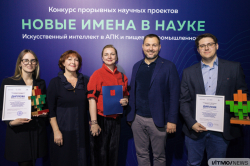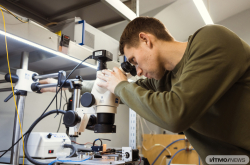Tell us more about EPDE. What does it stand for?
EDPE stands for Evolutionary Partial Differential Equation.

EPDE. Credit: github.com
Other algorithms can only estimate the percentage of data that can be described with any particular values in an equation. This results in extensively long equations that take a long time to generate. An “untrained” computer will suggest too many options when it tries to come up with formulas to explain observations.
Our suggestion was that a heuristic algorithm would be able to sort out the obviously non-fitting solutions, opting for the most promising ones. Heuristics in this case means giving some specific data to a computer to solve a specific problem. There are around a hundred formulas in contemporary mathematical physics, of which our AI was originally completely oblivious; but we taught it the basics of generating equations.
How did you come up with the idea of teaching AI to identify the laws of the universe?
It took even a genius like Newton a long time to study the world around him before he could formulate his laws and equations. Today, scientists are expected to produce discoveries faster and more frequently. However, not all processes can be easily tracked and analyzed, especially in fields with a stronger human element, such as economics, social sciences, and psychology.
It is often the case that experts in the field can intuit the existence of fundamental laws in their domain, but they cannot exactly put them into words. But an AI – when properly trained – can.
What was the development process like?
EPDE’s first prototype was created by our team of five in just a month. We wrote a paper and presented it at the International Conference on Computational Science (CORE A-ranked conference).
In Russia, our work was supported by ITMO’s Research Center “Strong AI in Industry,” grants from the Russian Science Foundation, and the national project Science and Universities.
We keep improving EPDE: for instance, we try to decrease the time needed to find the most exact mathematical formula to describe data. In a sense, we teach an AI to “act” like a scientist’s mind.
The AI is capable of describing processes of varied scale: for some, it picks a general equation; for others – a more detailed one. However, that’s not all: it can not only identify patterns and generate equations, but also explain them.
What is the importance of that?
In research, it is not enough to just come up with an equation; you must also convince physicists, biologists, economists, or other experts that it didn’t just appear out of thin air. And that’s what our tool is capable of. Even if the data is incomplete, the algorithm can perform some additional processing to fill in the gaps. We are the first in Russia to have created such a tool.
What problems has EPDE already solved?
We started with physics: we modeled sea waves and ice cover in the ocean. As a result, we were able to prove that based on the known parameters, the algorithm can generate two different equations for shallow and deep water.
The suggested formulas characterized the waves in a particular part of the ocean quite precisely; at the same time, the algorithm wasn’t given any basic information on hydrodynamics. In order to turn our product into a working tool, we taught it not just to suggest, but also to solve equations.
Next, we used it to generate differential equations that describe a calorimeter’s transition states for the first time (a calorimeter is used to measure changes in heat). These equations can be used to design engines or refrigeration units. This would be impossible to achieve without AI: the transition states are extremely short, making it nearly unreal to conduct so many computations manually.
What’s more, the algorithm helped study physical methods of treating cancer. We processed data from an experiment that modeled how a laser’s heat affects the human body; then, we determined how much of this heat is transferred through convection (in this kind of heat exchange, a substance’s inner energy is transferred through its flows), and calculated the corresponding coefficient in an equation.
It turned out that the share of convection compared to diffusion (when molecules of two substances mutually permeate each other) is small and the heating can be described with an easier formula than it was initially believed.
What’s the next step?
We will continue testing the algorithm in various applications. For instance, we are analyzing information transfer over secure channels and participating in experiments that model how swarm robots behave in a magnetic field.
Our major objective is to discover laws-of-physics-like formulas for social sciences, economics, and humanities – sciences where unpredictable factors play a big role. We have already started working on it: currently, we are looking for explanations of phenomena that haven’t really been theorized or studied.
By the way, in 1975 the Soviet scientist Leonid Kantorovich was awarded the Nobel Prize in Economics for a differential equation that describes economic processes.




